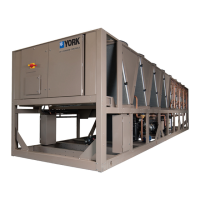JOHNSON CONTROLS
40
SECTION 4 - INSTALLATION
Form 201.28-NM1.1
Issue date: 08/06/2021
Water treatment
The unit performance provided in the Design Guide
is based on a fouling factor of 0.018 m2/hr °C/kW
(0.0001 ft2hr°F/Btu). Dirt, scale, grease and certain
types of water treatment will adversely affect the heat
exchanger surfaces and therefore the unit performance.
Foreign matter in the water systems can increase the
heat exchanger pressure drop, reducing the flow rate and
causing potential damage to the heat exchanger tubes.
Aerated, brackish or salt water is not recommended
for use in the water systems. Johnson Controls recom-
mends that a water treatment specialist should be con-
sulted to determine whether the proposed water com-
position will adversely affect the evaporator materials
of carbon steel and copper. The pH value of the water
flowing through the evaporator must be kept in a range
between 7 and 8.5.
Pipework arrangement
The following is a suggested piping arrangement for
single unit installations.
Figure 8 - Pipework arrangement
LD15151
-Isolating Valve - Normally open
-Isolating Valve - Normally closed
-Flow Regulating Valve
-Flow Measurement Device
-Strainer
-Pressure Tapping
-Flow Switch
-Flanged Connection
-Pipework
Minimum water volume
It is good practice to include as much water volume
as possible in a chilled water loop. This increases the
thermal mass and flywheel effect within the system
(that is, the more; the better) which in turn promotes
stable water temperature control and increases reliabil-
ity by reducing compressor cycling.
For air conditioning applications, a minimum of 3
gallons/ton is required. with a preferred gallon/ton
ratio to be within the 5 to 8 range. For process applica-
tions, a minimum of 6 gallons/ton ratio is required with
preference towards a range of 7 to 11. Install a tank or
increase pipe sizes to provide sufficient water volume.
Leaving water temperature out of range
The YVAA chiller line has a maximum leaving water
temperature of 15.6°C (60°F). Where process applica-
tions require a chilled water temperature higher than
what the chiller provides, a simple piping change can
remove the problem. By using a mixture of chiller-
cooled water and returning process water, the chilled
water entering the process can be held at the desired
temperature. A tank can also be used to meet high
leaving water temperature requirements.
Each YVAA evaporator has a minimum and maximum
flow rate. Some process applications require a flow
rate that is out of range for the evaporator. In those ap-
plications, a piping change can remove the problem.
In applications where the required flow rate is less than
the evaporator’s minimum allowable, the chilled water
can be recirculated to the chiller.
Figure 9 - Leaving water temperature out of range
suggested layout
LD15049
Recirculation
Supply to load
Return from load
Load

